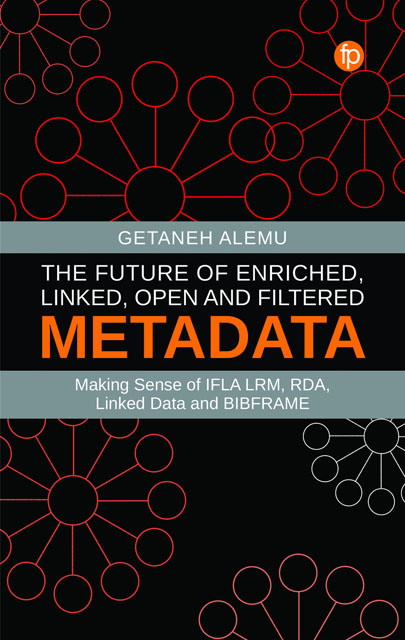 The Future of Enriched, Linked, Open and Filtered Metadata
The Future of Enriched, Linked, Open and Filtered Metadata Book contents
- Frontmatter
- Contents
- Figures
- Tables
- Code snippets
- About the Author
- Preface
- Acknowledgements
- Abbreviations
- 1 Introduction to Metadata
- 2 Metadata Strategies and Quality Indicators
- 3 Metadata Use Cases
- 4 Contemporary Metadata Principles
- 5 Enriched and Linked Metadata
- 6 Open Metadata
- 7 Filtered Metadata
- 8 FRBR, LRM and the Notion of Work
- 9 Resource Description and Access (RDA)
- 10 BIBFRAME: A New Metadata Framework
- 11 Crowdsourcing and User-Generated Metadata
- References
- Index
11 - Crowdsourcing and User-Generated Metadata
Published online by Cambridge University Press: 18 November 2022
- Frontmatter
- Contents
- Figures
- Tables
- Code snippets
- About the Author
- Preface
- Acknowledgements
- Abbreviations
- 1 Introduction to Metadata
- 2 Metadata Strategies and Quality Indicators
- 3 Metadata Use Cases
- 4 Contemporary Metadata Principles
- 5 Enriched and Linked Metadata
- 6 Open Metadata
- 7 Filtered Metadata
- 8 FRBR, LRM and the Notion of Work
- 9 Resource Description and Access (RDA)
- 10 BIBFRAME: A New Metadata Framework
- 11 Crowdsourcing and User-Generated Metadata
- References
- Index
Summary
Overview
This chapter presents metadata as a people-centred anduser-driven approach at all its stages: creation,management and use. It argues that metadata can beenriched by cataloguers, subject experts, users andmachines. However, most library standards currentlyfocus on metadata that cataloguers and metadataexperts create. In some cases, such as institutionalrepositories, subject experts such as authors ofpublications are asked to contribute some basicmetadata. This chapter aims to explain how users cancontribute and complement metadata to describeinformation resources. With Web 2.0, newopportunities arise for a participatory paradigmwith users engaged in metadata creation. In contrastto librarian/archivist-defined (standards-based)metadata, the participatory paradigm (O’Reilly,2005) provides new metadata creation and utilisationopportunities. Whether it is called socialcataloguing, crowdsourcing, folksonomy,folksontology or democratic classification, Gartner(2016) argues that the Web 2.0 approach to metadataamounts to a paradigm shift.
Users as metadata creators
This chapter focuses on the principle of metadataenriching by users as cocreators and its applicationfor digital heritage. The argument for sociallyconstructed, user-generated metadata or metadataco-creation is not a new phenomenon (Alemu et al.,2012; Alemu, 2018; Casey and Savastinuk, 2006;Maness, 2006; Miller, 2005). For example,Smith-Yoshimura and Shein (2011) wrote that‘traditionally, staff at galleries, libraries,archives, and museums (GLAMs) create metadata forthe content they manage. However, social metadata –content contributed by users – is evolving toaugment and contextualise the content and metadatacreated by GLAMs.’
According to Lankes (2016), user engagement happenswhen libraries provide a platform co-owned by thecommunity, which can harness creativity andco-creation. Weinberger (2012a) is of the view thatsociety as a whole is better off by embracing‘information [knowledge] overload’ generated by anetwork of experts without necessarily having thetraditional pre-publication filters – thusincorporating varied, diverse, possibly unsettledbut continually enhancing discourses(conversations). This, however, does not mean thatanything that goes to the network is authentic,credible and trustworthy. What is suggested here isa post-filtering mechanism, where the contributionsare exposed to open scrutiny where ideas aretransparently debated and argued (Weinberger, 2012a;2012b). In the end, truth and facts do matter –however they come after publication.
- Type
- Chapter
- Information
- The Future of Enriched, Linked, Open and Filtered MetadataMaking Sense of IFLA LRM, RDA, Linked Data andBIBFRAME, pp. 237 - 256Publisher: FacetPrint publication year: 2022


